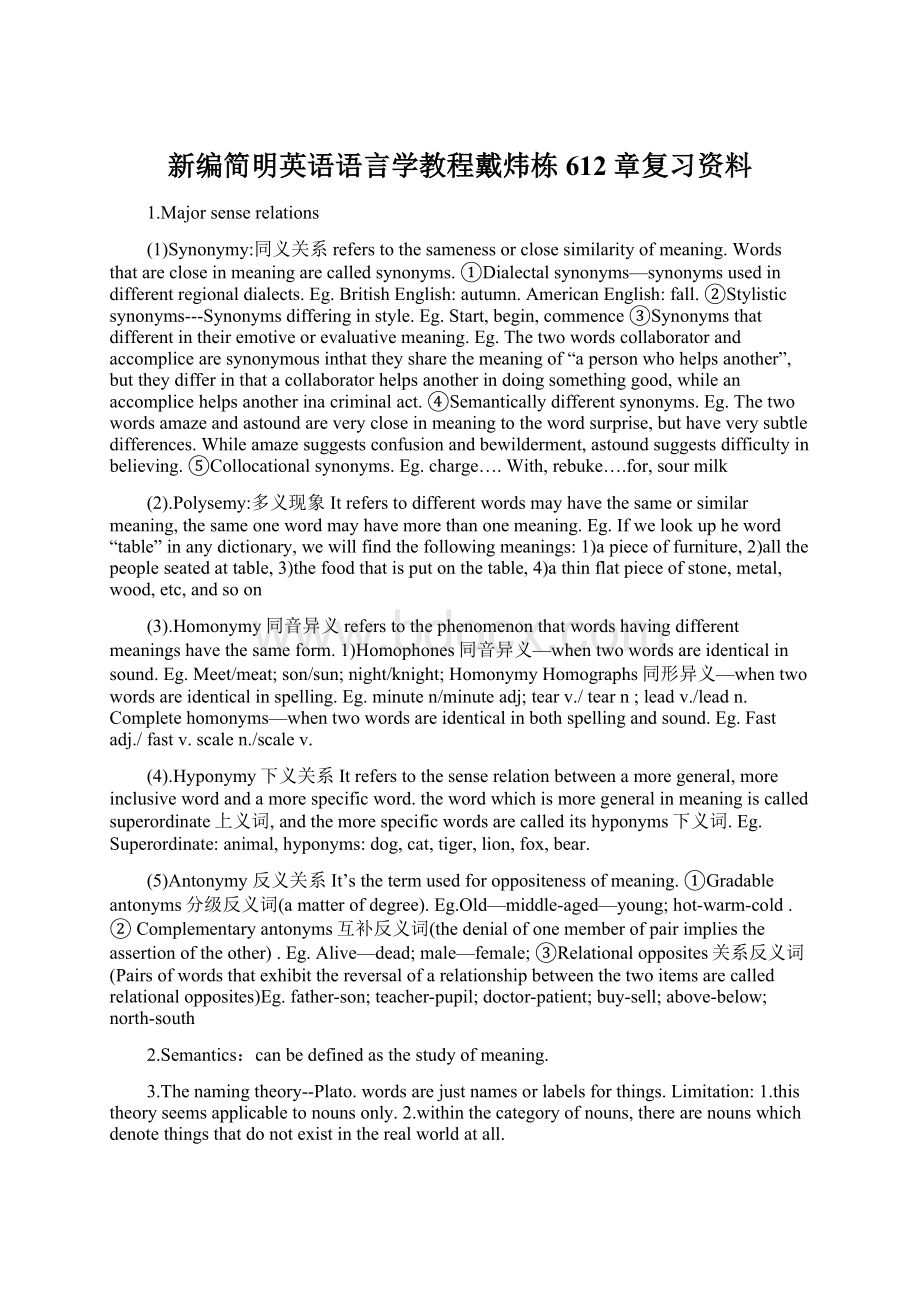新编简明英语语言学教程戴炜栋612章复习资料.docx
《新编简明英语语言学教程戴炜栋612章复习资料.docx》由会员分享,可在线阅读,更多相关《新编简明英语语言学教程戴炜栋612章复习资料.docx(7页珍藏版)》请在冰豆网上搜索。

新编简明英语语言学教程戴炜栋612章复习资料
1.Majorsenserelations
(1)Synonymy:
同义关系referstothesamenessorclosesimilarityofmeaning.Wordsthatarecloseinmeaningarecalledsynonyms.①Dialectalsynonyms—synonymsusedindifferentregionaldialects.Eg.BritishEnglish:
autumn.AmericanEnglish:
fall.②Stylisticsynonyms---Synonymsdifferinginstyle.Eg.Start,begin,commence③Synonymsthatdifferentintheiremotiveorevaluativemeaning.Eg.Thetwowordscollaboratorandaccomplicearesynonymousinthattheysharethemeaningof“apersonwhohelpsanother”,buttheydifferinthatacollaboratorhelpsanotherindoingsomethinggood,whileanaccomplicehelpsanotherinacriminalact.④Semanticallydifferentsynonyms.Eg.Thetwowordsamazeandastoundareverycloseinmeaningtothewordsurprise,buthaveverysubtledifferences.Whileamazesuggestsconfusionandbewilderment,astoundsuggestsdifficultyinbelieving.⑤Collocationalsynonyms.Eg.charge….With,rebuke….for,sourmilk
(2).Polysemy:
多义现象Itreferstodifferentwordsmayhavethesameorsimilarmeaning,thesameonewordmayhavemorethanonemeaning.Eg.Ifwelookupheword“table”inanydictionary,wewillfindthefollowingmeanings:
1)apieceoffurniture,2)allthepeopleseatedattable,3)thefoodthatisputonthetable,4)athinflatpieceofstone,metal,wood,etc,andsoon
(3).Homonymy同音异义referstothephenomenonthatwordshavingdifferentmeaningshavethesameform.1)Homophones同音异义—whentwowordsareidenticalinsound.Eg.Meet/meat;son/sun;night/knight;HomonymyHomographs同形异义—whentwowordsareidenticalinspelling.Eg.minuten/minuteadj;tearv./tearn;leadv./leadn.Completehomonyms—whentwowordsareidenticalinbothspellingandsound.Eg.Fastadj./fastv.scalen./scalev.
(4).Hyponymy下义关系Itreferstothesenserelationbetweenamoregeneral,moreinclusivewordandamorespecificword.thewordwhichismoregeneralinmeaningiscalledsuperordinate上义词,andthemorespecificwordsarecalleditshyponyms下义词.Eg.Superordinate:
animal,hyponyms:
dog,cat,tiger,lion,fox,bear.
(5)Antonymy反义关系It’sthetermusedforoppositenessofmeaning.①Gradableantonyms分级反义词(amatterofdegree).Eg.Old—middle-aged—young;hot-warm-cold.②Complementaryantonyms互补反义词(thedenialofonememberofpairimpliestheassertionoftheother).Eg.Alive—dead;male—female;③Relationalopposites关系反义词(Pairsofwordsthatexhibitthereversalofarelationshipbetweenthetwoitemsarecalledrelationalopposites)Eg.father-son;teacher-pupil;doctor-patient;buy-sell;above-below;north-south
2.Semantics:
canbedefinedasthestudyofmeaning.
3.Thenamingtheory--Plato.wordsarejustnamesorlabelsforthings.Limitation:
1.thistheoryseemsapplicabletonounsonly.2.withinthecategoryofnouns,therearenounswhichdenotethingsthatdonotexistintherealworldatall.
4.Theconceptualistview:
thereisnodirectlinkbetweenalinguisticformandwhatitrefersto;intheinterpretationofmeaningtheyarelinkedthroughthemediationofconceptsinthemind../semantictriangle语义三角,triangleofsignificance意义三角
5.Contextualism:
J.R.Firth.It’sbasedonthepresumptionthatonecanderivemeaningfromorreducemeaningtoobservablecontexts./thesituationalandthelinguisticcontext.
6.Behaviorism:
Bloomfield.Itreferstotheattemptedtodefinethemeaningofalanguageformasthe”situationinwhichthespeakeruttersitandtheresponseitcallsforthinthehearer”.
7.Sense:
It’sconcernedwiththeinherentmeaningofthelinguisticform.It’sthecollectionofallthefeaturesofthelinguisticform,it’sabstractandde-contextualized.(Itistheaspectofmeaningdictionarycompiliersareinterested)
8.Reference:
Itmeanswhatalinguisticformreferstointhereal,physicalworld,itdealswiththerelationshipbetweenthelinguisticelementandthenon-linguisticworldofexperience.
Acertainsensecanberealizedbymorethanonereferences,acertainreferencecanbeexpressedbymorethanonesense.Linguisticformshavingthesamesensemayhavedifferentreferencesindifferentsituations.
9.senserelationbetweensentences句子间的意义关系XissynonymouswithY.(同义),XisinconsistentwithY.(不一致),XentailsY.(X包含于Y中),XpresupposesY.(Y是X的先决条件),Xisacontradiction.(自我矛盾),Xissemanticallyanomalous.(语义反常)
10.Componentialanalysis(CA)成分分析—awaytoanalyzelexicalmeaning.Itisawayproposedbythestructuralsemanticiststoanalyzewordmeaning.Theapproachisbaseduponthebeliefthatthemeaningofawordcanbedissectedintomeaningcomponents,calledSemanticfeatures.
Plusandminimumssignsareusedtoindicatewhetheracertainsemanticfeatureispresentorabsent,thesefeaturesymbolsareusuallywrittenincapitalizedletters.Eg.Boy=[+HUMAN][-ADULT][+MALE]man=[+HUMAN][+ADULT][+MALE]
11.PredicationAnalysis述谓结构分析—awaytoanalyzesentencemeaning,由BritishLinguistG.Leech提出Predicationistheabstractionofthemeaningofasentence,itappliestoallformsofasentence,includingstatements,imperativeandinterrogative.(themeaningofasentenceisnotthesumtotalofthemeaningsofallitscomponents.)1)grammatical2)semanticmeaning.
PredicationconsistsofArguments变元andPredicates谓词.Anargumentisalogicalparticipantinapredication,largelyidenticalwiththenominalelementsinasentence,apredicateissomethingsaidaboutanargumentoritstatesthelogicalrelationlinkingtheargumentsinasentence.one-placepredicationeg,“Tomsmokes”argument:
”TOM”predicate:
“SMOKE”,thepredition:
TOM(SMOKE),two-placepredication)eg,“Kidslikeapples”KID,APPLE(LIKE),no-placepredicationeg,“Itishot”(BETHOT).
12.Pragmatics:
语用学Pragmaticsisthestudyofhowspeakersofalanguageusesentencestoeffectsuccessfulcommunication.
13.PragmaticsVSSemantics:
distinguish→context,ThepublicationofSaussure’sworkCourseofGeneralLinguisticsintheearly20thcenturymarkedthebeginningofmodernlinguistics.
14.Context:
it’sgenerallyconsideredasconstitutedbytheknowledgesharedbythespeakerandthehearer.
15.SentencemeaningandUtterancemeaning:
Ifwetakeitasagrammaticalunitandconsideritasaseli-containedunitinisolationfromcontext,thenweareregardingitasasentence./Ifwetakeitassomethingaspeakeruttersinacertainsituationwithacertainpurpose,thenwearetakingittobeanutterance.区别:
themeaningofsentenceisabstract,anddecontextualized,anutteranceisconcrete,contextualized.联系:
Themeaningofanutteranceisbasedonsentencemeaning,it’stherealizationoftheabstractmeaningofasentenceinarealsituationofcommunication,orsimplyinacontext.
Eg.Nowtakethesentence“Theroomismessy”asanexample.Semanticanalysisofthemeaningofthesentenceresultsintheone-placepredicationROOM(BEMESSY).Thenapragmaticanalysisoftheutterancewillrevelwhatthespeakerintendtodowithit.Forexample,itcouldhavebeenutteredbyamotherandherson,whenamotherenteredintoherson’sroom,andfoundhisroomwasindisorder.Thusshesaidtoherson:
”Theroomismessy.”Sheinfactwasblaminghimforlazinessandaskedhimtocleanit.
16.Speechacttheory言语行为理论:
(1)首先JohnAustin.It’sanimportanttheoryinthepragmaticstudyoflanguage.it’saphilosophicalexplanationofthenatureoflinguisticcommunication.itaimstoanswerthequestion”whatdowedowhenusinglanguage?
”Austin’smodel:
Constatives叙事话语:
werestatementsthateitherstateordescribe,andwerethusverifiable.performatives行事话语:
didnotstateafactordescribeastate,andwerenotverifiable然后又建立了三种行为理论:
locutionaryact言内行为→句子词组的表面意义,illocutionaryact言外行为→暗含义,perlocutionaryact言后行为→执行的动作,以youhaveleftthedoorwideopen为例.Locutionaryact:
:
expressedwhateachwordofthissentenceliterallymean.illocutionaryact:
expressedhisintentionofspeaking,askingsomeonetoclosethedoor.Perlocutionaryact:
someoneheardthesentence,andclosethedoor,thenthisactissuccessfullyperformed.语言学家对言外行为illocutionaryact最感兴趣
(2).美国哲学语言学家JohnSearle对言外行为分成了5类1)阐述性Representatives---statingordescribing,sayingwhatthespeakerbelievestobetrue例词:
stating,believing,swearing,hypothesizing最有代表性,2)指令性Directives---tryingtogetthehearertodosomething例词:
inviting,suggesting,requesting,advising,warning,threatening,ordering3)承诺性Commissives---future例词:
promising,undertaking,vowing4)表达类Expressives---thespeakerisexpressinghisfeelingsorattitudetowardsanexistingstateofaffairs.例词:
apologizing,thanking,congratulating5)宣告类Declarations---thesuccessfulperformanceofanactofthistypebringsaboutthecorrespondencebetweenwhatissaidandreality.例句Inowdeclarethemeetingopen/Iappointyouchairmanofthecommittee/Ifireyou.这五类differintheirstrengthorforce.
17.Principleofconversation会话原则→CooperativePrinciple合作原则:
InGrice’sview,toconversewitheachother,theparticipantsmustfirstofallbewillingtocooperate;otherwise,itwouldnotbepossibleforthemtocarryonthetalk.ThisgeneralprincipleiscalledtheCooperativePrinciple(CP)1)themaximofQuantity数量原则---你说的话应包含所需内容且不可超过内容要求eg.A:
WhenisSusan’sfarewellparty?
B:
Sometimenextmonth.2)themaximofQuality质量原则---不说你认为是假的话或你缺乏足够证据的话.Eg.A:
WouldyouliketojoinusforthepicniconSunday?
B:
I’mafraidIhavegotaclassonSunday.3)themaximofrelation关系原则--使你的话与话题相关eg.A:
Howdidmathexamgotoday,Tom?
B:
WehadaBasketballmatchwiththeotherclassandwebeatthem.4)themaximofmanner方式原则--避免模糊、歧义,应简明有序。
Eg.A:
Shallwegetsomethingforthekids.B:
Yes.ButIvetoI-C-E-C-R-E-A-M.
18.Additionofnewwords1)Coinage创新词:
Anewwordcanbecoinedoutrighttofitsomepurpose,mostlyfornewthingsandobjects.Eg.digitalcamera,Taikonaut.2